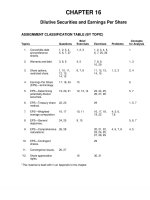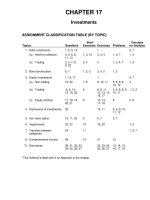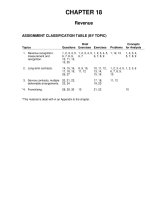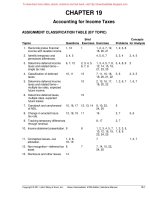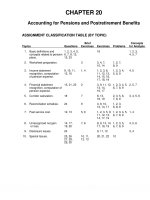Intermediate accounting IFRS 3rd ch11
Bạn đang xem bản rút gọn của tài liệu. Xem và tải ngay bản đầy đủ của tài liệu tại đây (3.02 MB, 98 trang )
Prepared by
Coby Harmon
University of California, Santa Barbara
11-1
Westmont College
CHAPTER 11
Depreciation,
Impairments, and Depletion
LEARNING OBJECTIVES
After studying this chapter, you should be able to:
1.
Describe depreciation concepts and methods of
4.
mineral resources.
depreciation.
2.
Identify other depreciation issues.
3.
Explain the accounting issues related to asset
impairment.
11-2
Discuss the accounting procedures for depletion of
5.
Apply the accounting for revaluations.
6.
Demonstrate how to report and analyze property,
plant, equipment, and mineral resources.
PREVIEW OF CHAPTER 11
Intermediate Accounting
IFRS 3rd Edition
Kieso ● Weygandt ● Warfield
11-3
LEARNING OBJECTIVE 1
Depreciation—A Method
Describe depreciation concepts and methods of
depreciation.
of Cost Allocation
Depreciation is the accounting process of allocating the cost of tangible assets to expense in a
systematic and rational manner to those periods expected to benefit from the use of the asset.
Allocating costs of long-lived assets:
11-4
Fixed assets = Depreciation expense
Intangibles = Amortization expense
Mineral resources = Depletion expense
LO 1
Depreciation—Method of Cost Allocation
Factors Involved in the Depreciation Process
Three basic questions:
11-5
1.
What depreciable base is to be used?
2.
What is the asset’s useful life?
3.
What method of cost apportionment is best?
LO 1
Factors Involved in Depreciation Process
Depreciable Base for the Asset
ILLUSTRATION 11.1
Computation of Depreciation Base
11-6
LO 1
Factors Involved in Depreciation Process
Estimation of Service Lives
11-7
Service life often differs from physical life.
Companies retire assets for two reasons:
1.
Physical factors (casualty or expiration of physical life).
2.
Economic factors (inadequacy, supersession, and obsolescence).
LO 1
Depreciation—Method of Cost Allocation
Methods of Depreciation
The profession requires the method employed be “systematic and rational.” Methods used include:
11-8
1.
Activity method (units of use or production).
2.
Straight-line method.
3.
Diminishing (accelerated)-charge methods:
a.
Sum-of-the-years’-digits.
b.
Declining-balance method.
LO 1
Methods of Depreciation
Activity Method
ILLUSTRATION 11.2
Data Used to Illustrate
Depreciation Methods
Data for Stanley Coal
Mines
Illustration: If Stanley uses the crane for 4,000 hours the first year, the depreciation charge is:
ILLUSTRATION 11.3
Depreciation Calculation,
Activity Method—Crane
Example
11-9
LO 1
Methods of Depreciation
Straight-Line Method
ILLUSTRATION 11.2
Data Used to Illustrate
Depreciation Methods
Data for Stanley Coal
Mines
Illustration: Stanley computes depreciation as follows:
ILLUSTRATION 11.4
Depreciation Calculation,
Straight-Line Method—Crane Example
11-10
LO 1
Methods of Depreciation
Diminishing-Charge Methods
ILLUSTRATION 11.2
Data Used to Illustrate
Depreciation Methods
Data for Stanley Coal
Mines
Sum-of-the-Years’-Digits. Each fraction uses the sum of the years as a denominator (5 + 4 + 3 + 2 + 1 = 15).
The numerator is the number of years of estimated life remaining as of the beginning of the year.
Alternate sum-of-the-years’ calculation
n(n+1)
=
=
2
11-11
5(5+1)
15
2
LO 1
Methods of Depreciation
Sum-of-the-Years’-Digits
ILLUSTRATION 11.6
Sum-of-the-Years’-Digits Depreciation Schedule—Crane Example
11-12
LO 1
Methods of Depreciation
Diminishing-Charge Methods
ILLUSTRATION 11.2
Data Used to Illustrate
Depreciation Methods
Data for Stanley Coal
Mines
Declining-Balance Method.
11-13
Utilizes a depreciation rate (percentage) that is some multiple of the straight-line method.
Does not deduct the salvage value in computing the depreciation base.
LO 1
Methods of Depreciation
Declining-Balance Method
ILLUSTRATION 11.7
Double-Declining Depreciation Schedule—Crane Example
11-14
LO 1
LEARNING OBJECTIVE 2
Other Depreciation Issues
Identify other depreciation issues.
Component Depreciation
IFRS requires that each part of an item of property, plant, and equipment that is significant to the total
cost of the asset must be depreciated separately.
11-15
LO 2
Component Depreciation
Illustration: EuroAsia Airlines purchases an airplane for €100,000,000 on January 1, 2020. The airplane has a
useful life of 20 years and a residual value of €0. EuroAsia uses the straight-line method of depreciation for all its
airplanes. EuroAsia identifies the following components, amounts, and useful lives.
ILLUSTRATION 11.8
Airplane Components
11-16
LO 2
Component Depreciation
Computation of depreciation expense for EuroAsia for 2020.
ILLUSTRATION 11.9
Computation of
Component Depreciation
Depreciation journal entry for 2020.
Depreciation Expense
8,600,000
Accumulated Depreciation—Equipment
11-17
8,600,000
LO 2
Component Depreciation
On the statement of financial position at the end of 2020, EuroAsia reports the airplane as a single amount.
ILLUSTRATION 11.10
Presentation of Carrying Amount of Airplane
11-18
LO 2
Other Depreciation Issues
Depreciation and Partial Periods
How should companies compute depreciation for partial periods?
Companies determine the depreciation expense for the full year and then
prorate this depreciation expense between the two periods involved.
This process should continue throughout the useful life of the asset.
11-19
LO 2
Depreciation and Partial Periods
Illustration—(Four Methods): Maserati SpA purchased a new machine for its assembly process on August 1, 2019.
The cost of this machine was €150,000. The company estimated that the machine would have a salvage value of
€24,000 at the end of its service life. Its life is estimated at 5 years and its working hours are estimated at 21,000
hours. Year-end is December 31.
Instructions: Compute the depreciation expense under the following methods.
11-20
(a) Straight-line depreciation.
(c)
(b)
Double-declining balance.
Activity method
(d)
Sum-of-the-years’-digits.
LO 2
Depreciation and Partial Periods
Straight-line Method
11-21
LO 2
Depreciation and Partial Periods
Activity Method
11-22
(Assume 800 hours used in 2019)
LO 2
Depreciation and Partial Periods
Sum-of-the-Years’-Digits Method
11-23
5/12 = .416667
7/12 = .583333
LO 2
Depreciation and Partial Periods
Double-Declining Balance Method
11-24
LO 2
Other Depreciation Issues
Depreciation and Replacement of PP&E
Does depreciation provide for the replacement of assets?
Does not involve a current cash outflow.
Funds for the replacement of the assets come from the revenues (generated through use of the
asset).
11-25
LO 2





